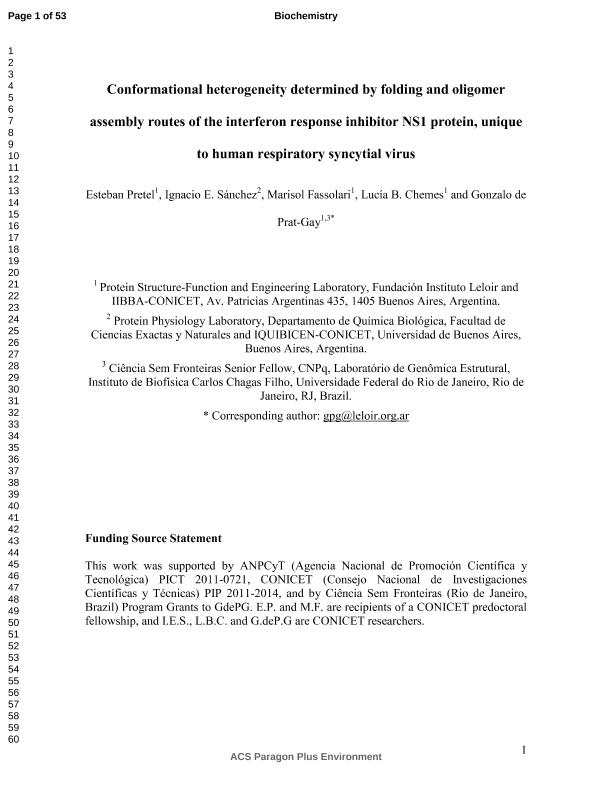Artículo
Conformational Heterogeneity Determined by Folding and Oligomer Assembly Routes of the Interferon Response Inhibitor NS1 Protein, Unique to Human Respiratory Syncytial Virus
Pretel, Miguel Esteban ; Sánchez Miguel, Ignacio Enrique
; Sánchez Miguel, Ignacio Enrique ; Fassolari, Marisol
; Fassolari, Marisol ; Chemes, Lucia Beatriz
; Chemes, Lucia Beatriz ; de Prat Gay, Gonzalo
; de Prat Gay, Gonzalo
 ; Sánchez Miguel, Ignacio Enrique
; Sánchez Miguel, Ignacio Enrique ; Fassolari, Marisol
; Fassolari, Marisol ; Chemes, Lucia Beatriz
; Chemes, Lucia Beatriz ; de Prat Gay, Gonzalo
; de Prat Gay, Gonzalo
Fecha de publicación:
08/2015
Editorial:
American Chemical Society
Revista:
Biochemistry
ISSN:
0006-2960
e-ISSN:
1520-4995
Idioma:
Inglés
Tipo de recurso:
Artículo publicado
Clasificación temática:
Resumen
The nonstructural NS1 protein is an essential virulence factor of the human respiratory syncytial virus, with a predominant role in the inhibition of the host antiviral innate immune response. This inhibition is mediated by multiple protein-protein interactions, and involves the formation of large oligomeric complexes. There is neither a structure nor sequence or functional homologues of this protein, which points to a distinctive mechanism for blocking the interferon response among viruses. The NS1 native monomer follows a simple unfolding kinetics via a native-like transition state ensemble, with a half-life of 45 minutes, in agreement with a highly stable core structure at equilibrium. Refolding is a complex process that involves several slowly interconverting species compatible with proline isomerization. However, an ultra-fast folding event of 0.2 milliseconds half-life is indicative of a highly folding compatible species within the undolded state ensemble. On the other hand, the oligomeric assembly route from the native monomer, which does not involve unfolding, shows a monodisperse and irreversible end-point species triggered by mild temperature change, with a half-life of 160 and 26 minutes at 37 and 47 degrees Celsius, respectively, and at low protein concentration (10 micromolar). A large secondary structure change into beta-sheet structure and the formation of a dimeric nucleus precedes polymerization by the sequential addition of monomers at the surprisingly low rate of one monomer every 34 seconds. The polymerization phase is followed by the binding to thioflavin-T indicative of amyloid-like, albeit soluble, repetitive beta sheet quaternary structure. The overall process is reversible only up until ~8 minutes, a time window where most of the secondary structure change takes place. NS1?s multiple binding activities must accommodate in a few binding interfaces at most, something to be considered remarkable given its small size (15 KDa). Thus, conformational heterogeneity, and in particular oligomer formation, may provide a means to expand its binding repertoire. These equilibria will be determined by variables such as macromolecular crowding, protein- protein interactions, expression levels, turnover, or specific subcellular localization. The irreversible and quasi-spontaneous nature of the oligomer assembly, together with the fact that NS1 is the most abundant viral protein in infected cells, makes its accumulation highly conceivable in conditions compatible with the cellular milieu. The implications of NS1 oligomers in the viral life cycle and the inhibition of host innate immune response remainto be determined.
Archivos asociados
Licencia
Identificadores
Colecciones
Articulos(IQUIBICEN)
Articulos de INSTITUTO DE QUIMICA BIOLOGICA DE LA FACULTAD DE CS. EXACTAS Y NATURALES
Articulos de INSTITUTO DE QUIMICA BIOLOGICA DE LA FACULTAD DE CS. EXACTAS Y NATURALES
Citación
Pretel, Miguel Esteban; Sánchez Miguel, Ignacio Enrique; Fassolari, Marisol; Chemes, Lucia Beatriz; de Prat Gay, Gonzalo; Conformational Heterogeneity Determined by Folding and Oligomer Assembly Routes of the Interferon Response Inhibitor NS1 Protein, Unique to Human Respiratory Syncytial Virus; American Chemical Society; Biochemistry; 54; 33; 8-2015; 5136-5146
Compartir
Altmétricas



